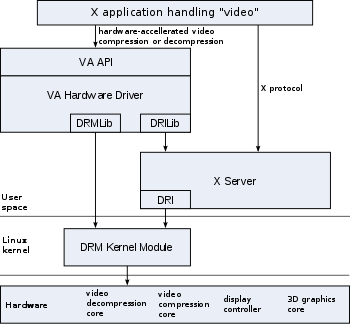Video Acceleration API
Video Acceleration API (VA-API) is a royalty-free API that allows applications such as VLC media player or GStreamer to use hardware video acceleration capabilities, usually provided by the graphics processing unit (GPU). It is implemented by the free and open-source library libva, combined with a hardware-specific driver, usually provided together with the GPU driver.
| Original author(s) | Intel |
|---|---|
| Initial release | September 13, 2007 |
| Stable release | 2.8.0
/ June 18, 2020 |
| Repository | github |
| Written in | C |
| Operating system | Linux, Android, BSD |
| Type | API |
| License | MIT License |
| Website | freedesktop |
VA-API video decode/encode interface is platform and window system independent but is primarily targeted at Direct Rendering Infrastructure (DRI) in X Window System on Unix-like operating systems (including Linux, FreeBSD, Solaris), and Android, however it can potentially also be used with direct framebuffer and graphics sub-systems for video output. Accelerated processing includes support for video decoding, video encoding, subpicture blending, and rendering.[1]
The VA-API specification was originally designed by Intel for its GMA (Graphics Media Accelerator) series of GPU hardware with the specific purpose of eventually replacing the XvMC standard as the default Unix multi-platform equivalent of Microsoft Windows DirectX Video Acceleration (DxVA) API, but today the API is no longer limited to Intel-specific hardware or GPUs.[2] Other hardware and manufacturers can freely use this open standard API for hardware accelerated video processing with their own hardware without paying a royalty fee.[3]
Overview
The main motivation for VA-API is to enable hardware-accelerated video decode at various entry-points (VLD, IDCT, motion compensation, deblocking[4]) for the prevailing coding standards today (MPEG-2, MPEG-4 ASP/H.263, MPEG-4 AVC/H.264, H.265/HEVC, and VC-1/WMV3). Extending XvMC was considered, but due to its original design for MPEG-2 MotionComp only, it made more sense to design an interface from scratch that can fully expose the video decode capabilities in today's GPUs.[5]
Supported hardware and drivers
As of 2019, VA-API is natively supported by:[6]
Supported video codecs
VA-API currently supports these video codecs in the official mainline version, but note that exactly which video codecs are supported depends on the hardware and the driver's capabilities.
- MPEG-2 decode acceleration Main Profile
- VC-1 / WMV3 decode acceleration Advanced Profile
- MPEG-4 Part 2 (H.263) (a.k.a. MPEG-4 SP / MPEG-4 ASP, more commonly known as Xvid) decode acceleration
- H.264 AVC encode acceleration Main Profile
- H.264 AVC decode acceleration High Profile
- H.264 / AVC Hardware Variable Length Decoding (VLD) - CABAC
- H.264 / AVC Hardware Variable Length Decoding (VLD) - CAVLC
- H.264 / AVC Hardware Inverse Transform (IT)
- H.264 / AVC Hardware Motion Compensation (HWMC)
- H.264 / AVC Hardware In-Loop Deblocking (ILDB)
- H.265/HEVC encode acceleration
- H.265/HEVC decode acceleration
- VP9 8-bit encode acceleration[7]
- VP9 8-bit and 10-bit decode acceleration[7]
Processes that can be accelerated with VA-API
Video decoding and post-processing processes that can be offloaded and accelerated if both the device drivers and GPU hardware supports them:
- Motion compensation (mocomp)
- Inverse discrete cosine transform (iDCT)
- In-loop deblocking filter
- Intra-frame prediction
- Variable-Length Decoding (VLD), more commonly known as slice-level acceleration
- Bitstream processing (CAVLC/CABAC)
Software architecture

The current interface is window system independent, so that it can potentially be used with graphics sub-systems other than the DRI (Direct Rendering Infrastructure) in X Window System, such as direct with framebuffer, and it can work with third-party DRM (Direct Rendering Manager) libraries. In a nutshell, it is a scheme to pass various types of data buffers from the application to the GPU for decoding or encoding a compressed bit-stream.
Software supporting VA-API
- Clutter (toolkit)
- Jellyfin media server
- Emby media server (starting from release 3.0.6400) [8]
- Helix media player (Linux)[9][10]
- ffmpeg, a command line tool from the FFmpeg project, supports VA-API encoding through CLI with version starting from 3.1 and also libavcodec (also part of the FFmpeg project) does contain code that other applications use to support hardware accelerated decoding, including VA-API.[11]
- Fluendo [12]
- Gnash Flash / SWF player[13]
- GStreamer through gstreamer-vaapi[14]
- Kodi (formerly XBMC Media Center) (Linux)[15]
- Kodibuntu (formerly XBMC Live) (Linux Live CD/USB operating-system)[15]
- MPlayer (v1 with patches)[16] and its fork mpv (native)
- MythTV (starting from release 0.25)[17]
- VLC media player (starting from release 1.1.0)[18]
- Bluecherry DVR client (starting from release 2.2.6)[19]
- Xine (via "xine-lib-vaapi" library) since Version 1.2.3 [20]
- Open Broadcaster Software[21]
See also
- Distributed Codec Engine (libdce) — Texas Instruments API for the video codec engine in OMAP based embedded systems
- OpenMAX — a royalty-free cross-platform media abstraction API from the Khronos Group
References
- "VA-API Video Acceleration On Intel Medfield - Phoronix". Phoronix.com. Retrieved 23 February 2019.
- "Video4Linux2: Path to a Standardized Video Codec API" (PDF). Events.linuxfoundation.org. Retrieved 23 February 2019.
- Nathan Willis (2009-07-01). "VA API slowly, but surely, making progress". Lwn.net.
- "Mplayer, FFmpeg Gain VA-API Support - Phoronix". Phoronix.com. Retrieved 23 February 2019.
- "vaapi". Freedesktop.org. Retrieved 23 February 2019.
- https://wiki.archlinux.org/index.php/Hardware_video_acceleration
- "Archived copy". Archived from the original on 2017-02-01. Retrieved 2017-01-20.CS1 maint: archived copy as title (link)
- "Emby Server 3.0.6400 Released". Emby.media. 29 August 2016. Retrieved 23 February 2019.
- "Mailing list entry that describes uses of VA-API". Lists.moblin.org. Retrieved 23 February 2019.
- "Archived copy". Archived from the original on 2012-03-24. Retrieved 2011-05-12.CS1 maint: archived copy as title (link)
- "Archived copy". Archived from the original on 2016-09-16. Retrieved 2016-08-31.CS1 maint: archived copy as title (link)
- "Fluendo's New Codecs Support VDPAU, VA-API - Phoronix". Phoronix.com. Retrieved 23 February 2019.
- "H.264 VA-API GPU Video Acceleration For Flash - Phoronix". Phoronix.com. Retrieved 23 February 2019.
- "Hardware-accelerated video decoding, encoding and processing on Intel graphics through VA-API". Cgit.freedesktop.org. Retrieved 23 February 2019.
- "XBMC Gets Working Intel VA-API Support - Phoronix". Phoronix.com. Retrieved 23 February 2019.
- "Archived copy". Archived from the original on 2013-08-03. Retrieved 2014-02-10.CS1 maint: archived copy as title (link)
- "Release Notes - 0.25 - MythTV Official Wiki". Mythtv.org. Retrieved 23 February 2019.
- "VLC 1.1.0 release - VideoLAN". Videolan.org. Retrieved 23 February 2019.
- "[Client] 2.2.6 Released – Significant CPU usage reductions included". Bluecherrydvr.com. 2 March 2017. Retrieved 23 February 2019.
- "the xine project - News Feed". Xine-project.org. Retrieved 23 February 2019.
- "OBS Studio Now Supports VA-API For Video Encoding - Phoronix". www.phoronix.com. Retrieved 2020-08-06.
External links
- Official website
- Intel Media and Audio for Linux
- mobile-hw-decode
- "VA API slowly -- but surely -- making progress" – an overview from 2009
- "MPlayer, FFmpeg Gain VA-API Support" – from 2008

